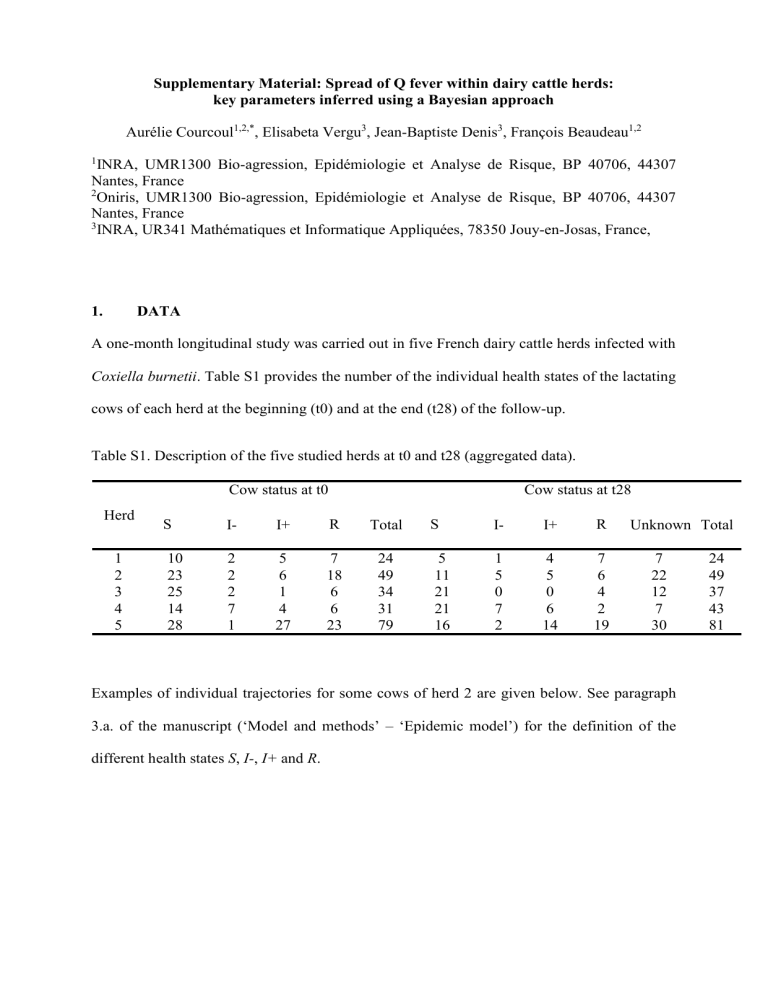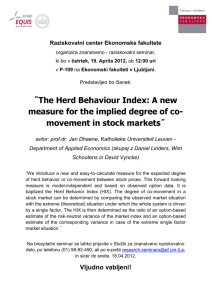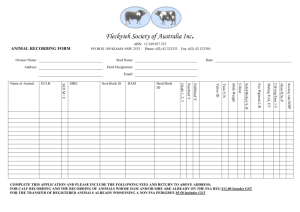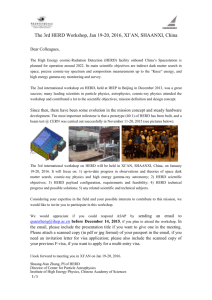Supplementary Material - Proceedings of the Royal Society B

Supplementary Material: Spread of Q fever within dairy cattle herds: key parameters inferred using a Bayesian approach
Aurélie Courcoul 1,2,* , Elisabeta Vergu 3 , Jean-Baptiste Denis 3 , François Beaudeau 1,2
1
INRA, UMR1300 Bio-agression, Epidémiologie et Analyse de Risque, BP 40706, 44307
Nantes, France
2
Oniris, UMR1300 Bio-agression, Epidémiologie et Analyse de Risque, BP 40706, 44307
3
Nantes, France
INRA, UR341 Mathématiques et Informatique Appliquées, 78350 Jouy-en-Josas, France,
1.
DATA
A one-month longitudinal study was carried out in five French dairy cattle herds infected with
Coxiella burnetii . Table S1 provides the number of the individual health states of the lactating cows of each herd at the beginning (t0) and at the end (t28) of the follow-up.
Table S1. Description of the five studied herds at t0 and t28 (aggregated data).
Cow status at t0 Cow status at t28
Herd
S I- I+ R Total S I- I+ R Unknown Total
1
2
3
4
5
10
23
25
14
28
2
2
2
7
1
5
6
1
4
27
7
18
6
6
23
24
49
34
31
79
5
11
21
21
16
1
5
0
7
2
4
5
0
6
14
7
6
4
2
19
7
22
12
7
30
24
49
37
43
81
Examples of individual trajectories for some cows of herd 2 are given below. See paragraph
3.a. of the manuscript (‘Model and methods’ – ‘Epidemic model’) for the definition of the different health states S , I, I+ and R .
Table S2. Evolution of observed individual health states over time for some cows of the data set.
Cow number
214
218
220
222
224
233
234
235
239
240 t0
S
S
R
S
I-
I+
I+
R
R
I+ t7
S
S
I+
S
I-
I+
I+
I+
R
I+ t14
S
S
R
S
S
I+
R
R
R
I+ t21
S
S
R
S
S
I+
I+
R
R
I+ t28
I-
S
R
S
S
I+
I+
R
R
I+
2.
LIKELIHOOD
From Equations (3.1) and (3.2) of the main text and considering that all variables are categorically distributed (i.e. they follow a multinomial distribution with the parameter n fixed at 1), the likelihood function of the complete data is given by:
L
O J , Q
i h
1 ,...,
1 ,...,
H
N ( h )
R i
0 , h
,..., R i
T , h
J
R
0
( i
, h
) t
T
0
U
O t
( i
, h
)
R t
( i
, h
) t
T
1
Q
R t
( i
, h
)
R t
( i
)
1 , h
, (S1) where random variables are assimilated to their realisations when used as indexes for reasons of simplicity (e.g. U
O t
( i
, h
)
, R t
( i
, h
)
P ( O t
( i
, h
) x k
R t
( i
, h
) x j
)
U x j x k
U jk
).
3.
CONVERGENCE OF THE MCMC ALGORITHM
Three chains were run: an initial burn-in of 10,000 runs with a thin interval of 600 was performed. Then, 50,000 iterations with the same thin interval were run. This thin interval ensures that the chains are no longer autocorrelated. All the 50,000 iterations were used to assess the posterior distributions. A total of 60 parameters were monitored: 25 for E t,h
, the environmental bacterial load at every sampling time in each herd, 20 for J h
, the distribution of the initial real health states in each herd, five for
, the herd-dependent mortality rate of C. burnetii , five for s , the herd-dependent transition rate for R to I+ and one for
1,
2
, m , q and r ,
the shedding and transition parameters. Among these 60 parameters, 35 are independent: 15 for J h
, five for
, five for s, five for p at time 1 of the follow-up and one for
1,
2
, m , q and r.
Moreover, Table S2 provides the Gelman-Rubin convergence diagnostic (or the potential scale reduction factor) for these 35 parameters.
The JAGS code used to make Bayesian inference is available on request from A. Courcoul
( aurelie.courcoul@oniris-nantes.fr
).
Table S3. Median and 97.5% percentile of the Gelman-Rubin potential scale reduction factors
(PSRF) for the 35 independent parameters of the model. The multivariate PSRF is equal to
1.51.
Parameter p
1
: transition rate S => Itime 0, herd 1 p
2
: transition rate S => Itime 0, herd 2 p
3
: transition rate S => Itime 0, herd 3 p
4
: transition rate S => Itime 0, herd 4 p
5
: transition rate S => Itime 0, herd 5 m : transition rate I => S q : transition rate I => I+ r : transition rate I+ => R s
1
: transition rate R => I+ - herd
1 s
2
: transition rate R => I+ - herd
2 s
3
: transition rate R => I+ - herd
3 s
4
: transition rate R => I+ - herd
4 s
5
: transition rate R => I+ - herd
5
1
: quantity of bacteria shed by an I per week
2
: quantity of bacteria shed by an I+ per week
1
: mortality rate of the bacterium, herd 1
2
: mortality rate of the bacterium, herd 2
3
: mortality rate of the bacterium, herd 3
1.08
1.03
1.04
1.00
1.03
1.01
1.00
1.00
1.01
1.01
1.00
1.01
1.04
1.08
1.00
1.01
1.14
1.01
Median
PSRF
97.5% percentile of the
PSRF
1.03
1.02
1.01
1.01
1.02
1.02
1.01
1.02
1.13
1.23
1.02
1.03
1.42
1.03
1.24
1.10
1.13
Parameter
4
: mortality rate of the bacterium, herd 4
5
mortality rate of the bacterium, herd 5
J
1,1
: proportion of S as initial real health state, herd 1
J
2,1
: proportion of S as initial real health state, herd 2
J
3,1
: proportion of S as initial real health state, herd 3
J
4,1
: proportion of S as initial real health state, herd 4
J
5,1
: proportion of S as initial real health state, herd 5
J
1,2
: proportion of I as initial real health state, herd 1
J
2,2
: proportion of I as initial real health state, herd 2
J
3,2
: proportion of I as initial real health state, herd 3
J
4,2
: proportion of I as initial real health state, herd 4
J
5,2
: proportion of I as initial real health state, herd 5
J
1,3
: proportion of I+ as initial real health state, herd 1
J
2,3
: proportion of I+ as initial real health state, herd 2
J
3,3
: proportion of I+ as initial real health state, herd 3
J
4,3
: proportion of I+ as initial real health state, herd 4
J
5,3
: proportion of I+ as initial real health state, herd 5
1.00
Median
PSRF
97.5% percentile of the PSRF
1.00
1.01
1.10
1.05
1.01
1.00
1.27
1.00
1.00
1.02
1.00
1.02
1.00
1.00
1.03
1.00
1.01
1.01
1.02
1.31
1.17
1.03
1.01
1.74
1.00
1.00
1.08
1.01
1.08
1.00
1.00
1.10
1.01
1.03
4.
POSTERIOR AND PRIOR DISTRIBUTIONS FOR TRANSITION AND
SHEDDING PARAMETERS
Figure S1 provides the prior and posterior distributions of four of the five transition rates between health states ( p , m , q , r and s ) and of the two shedding parameters
1
and
2
. As p , the transition rate from S to I (which represents the infection risk) and s , the transition rate from
R to I+ (which represents the intermittent shedding) are assumed to be herd-specific, five posterior distributions (one per herd) are given for these two parameters. For all these parameters, the posterior distributions cover shorter intervals than those defined by the prior distributions, which reveals that the data provide some information.
Figure S1. Prior (dotted black line) and posterior (solid lines) distributions of the model parameters: transition rate from S to I ( p), transition rate from I to S ( m ), transition rate from
I to I+ ( q ), transition rate from I+ to R ( r ), transition rate from R to I+ ( s ), quantity of bacteria shed by an I individual in a week (
1
) and quantity of bacteria shed by an I+ individual in a week (
2
).
5.
POSTERIORS AND PRIORS FOR THE ENVIRONMENT
Figure S2 provides the posterior distributions for the environmental bacterial load ( E ) for each herd at each time and for
, the mortality rate of the bacterium (which comprises the natural mortality of the bacterium and its removal in relation to the periodic cleaning of the cattle housing carried out by the farmer). For the initial environmental bacterial load and for
, priors are also given.
Figure S2. Posteriors for the environmental bacterial load ( E ) and for the mortality rate of the bacterium (
). For the initial environmental bacterial load and for
, priors are also drawn
(black dotted line). For the initial environmental bacterial load, posterior distributions cover shorter intervals than those defined by prior distributions, which reveals that the data provide some information. This is not the case for
.
6.
SUMMARY STATISTICS FOR THE INITIAL REAL HEALTH STATES
At the prior level, the initial real health states, R
( i
0
)
, h
, are random variables with a probability distribution specified by J , where J x j
P ( R
0
( i
, h
) x j
) with x j
Є {x
1
= S, x
2
=I-, x
3
=I+, x
4
=R} .
Table S4 provides summary statistics of posterior distributions for marginal probability distributions of initial real health state.
Table S4. Priors and posteriors for the probability of initial real health states ( J ) in each of the five herds. For the marginal prior and posterior distributions, medians and 95% credible intervals (CI) are shown.
Model parameter
Probability that the initial health state of cow i is S
Probability that the initial health state of cow i is I-
Probability that the initial health state of cow i is I+
Probability that the initial health state of cow i is R
Prior distribution
Dirichlet
(3.5,1,2.5,2)
0.380
(0.120 –
0.706)
0.082
(0.003 –
0.369)
0.261
(0.054 –
0.593)
0.203
(0.031 –
0.528)
Herd 1
0.327
(0.159 -
0.521)
0.062
(0.004 -
0.194)
0.237
(0.107 -
0.410)
0.351
(0.184 -
0.549)
Posterior median and 95% CI
Herd 2
0.439
(0.300 -
0.581)
0.031
(0.001 -
0.109)
0.140
(0.060 -
0.256)
0.377
(0.243 -
0.523)
Herd 3
0.688
(0.533 -
0.818)
0.032
(0.001 -
0.134)
0.079
(0.020 -
0.189)
0.183
(0.082 -
0.323)
(0.048 -
0.252)
Herd 4
0.524
(0.359 -
0.685)
0.189
(0.071 -
0.347)
0.143
(0.059 -
0.265)
0.129
Herd 5
0.306
(0.205 -
0.425)
0.015
(0.000 -
0.064)
0.336
(0.233 -
0.449)
0.333
(0.219 -
0.456)






